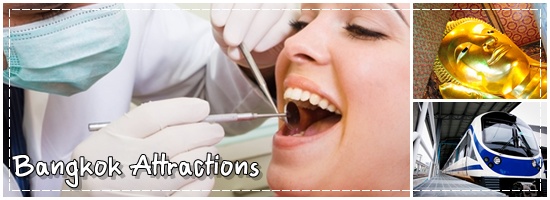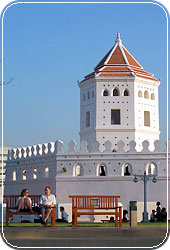
Santichaiprakarn Public Park
 This area was formerly abound in
perennial trees, especially Banyan and
Sonneratiace with firefiles swarming at
night. This area was formerly abound in
perennial trees, especially Banyan and
Sonneratiace with firefiles swarming at
night.
The site, covering an area of eight and
a half rai (approximately 3 acres),
belongs to the Crown Property Bureau. It
has been slated to be developed as a
public park for people recreation, in
line with the 8th National Economic and
Social Development Plan concerning the
enhancement of the people's qualityof
life, and the Committee to Conserve and
Develop Rattanakosin and Old Cities,
formerly the Rattanakosin Island
Committee.
The redevelopment is meant to highlight
the monument and to clearly define the
old Rattanakosin City. Perennial trees
are planted, including Golden Showers,
Thailand's national tree, Banyan and
Sonneratiaceae, to rehabilitate the area
and its ecosystem. The special part of
the construction includes ramps,
handrails and tactile blocks.
His Majesty the King has graciously
named the park as "Santichaiprakarn
Park".
Phra Sumen Fort
It was built in the reign of King Rama
I, in 1783, on the city's outer wall,
which ran along the city canal to the
Chao Phraya River.
At first, 14 forts were built, but in
time they became dilapidated.
Eventually, all were demolished, with
the exception of Phra Sumen Fort and
Mahakan Fort, both of which stand today.
Phra Sumen Fort has been listed as a
historical site, published in the Royal
Gazette issue 66 section 64 dated
November 22, 1949. It is the only city
fort left standing on the bank of the
Chao Phraya River.
From the renovation work in 1981, it was
discovered that the base of the Fort and
the wall are laid two meters deep, with
the height at the top marker of the Fort
measured at 10.50 meters, to the roof of
the turret 16.90 meters, and the entire
length of 45 meters.
Phra Sumen Fort is of three stages, with
three staircases on the inside, and
equipped with the bulwark and the board
to hide the cannon from sifht. There are
doors opening out from the lower and
upper stages. To the front of the Fort
is a wall with large polygonal markers,
each with small angel marks or crosses
carved on.
The second stage has a 16-step staircase
attached to the back. The wall is
decorated with pointed markers, with
carved pointed arches below them, four
on each side, with three lines of angel
marks at intervals. At the center, there
are rooms for ammunition and weaponry
storage.
The hexagonal turret and the rooftop
crumbed down during the Fifth Reign to
the Seventh Reign. There were renovated
on the occasion of the 200th founding
anniversary of Bangkok in 1982.
Santichaiprakarn Royal Pavilion
A tiny royal pavilion, 8.70 by 14.20
meters, is built on an area of 123.54
sq.m., and located within the project
area of the renovation of Phra Sumen
Fort and the redevelopment of the
surrounding areas as a public park. The
royal pavilion is simple in design, made
of wood, on a brick-and-stucco base,
featuring elaborate traditonal-woodworking
techniques inherited by Thai artisans.
His Majesty the King has graciously
named the pavilion as "Santichaiprakarn
Pavilion".
Santichaiprakarn Pavilion has been built
as a permanent structure representing
the Thai people's deep gratitude for His
Majesty the King's great kindness. It is
a gift to His Majesty the King by the
Government and the people to celebrate
the Auspicious
|